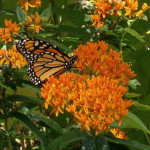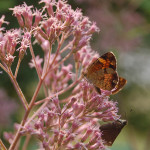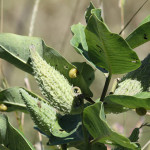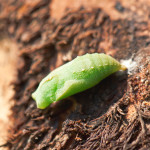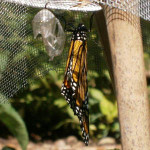View From
Rachel’s Window
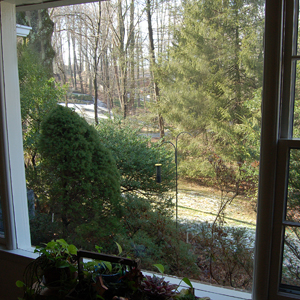
MINDFUL OF MONARCHS
September 15, 2015
From Rachel Carson’s windows there can be seen bees, butterflies and humming birds visiting a wealth of plants cultivated especially for pollinators including 3 varieties of milkweed (Asclepias): the low-growing A. tuberosa aka butterfly weed with bright orange blooms, the taller thin leaved A. incarnata aka swamp milkweed with raspberry colored flowers, and the familiar broad-leaved A. syriaca aka common milkweed. Except for a patch of incarnata all are now (mid September) without any blossoms.
The leaves of these milkweeds constitute important food sources for Monarch butterfly caterpillars. They only thrive on milkweed leaves. In addition, the milkweed blossoms provide nectar for adult Monarchs and other pollinators. The adult Monarch butterfly sips nectar and does not consume milkweed leaves.
A handful of Monarch butterflies as single individuals visited our pollinator garden this year during August and early September
Monarchs in Maine
About this same time of year (on September 10th 1963) Rachel Carson observed Monarch butterflies passing Newagen Point in Maine on their annual migration to Mexico. Rachel’s now famous letter about this sighting to her friend Dorothy Freeman expressed her admiration for the remarkable journey of these insects, one of the longest known to be made by butterflies, and showed in her special poetic style a noble acceptance of her own mortality. (Always, Rachel: The Letters of Rachel Carson and Dorothy Freeman (1952-1964), ed. Martha Freeman, 1995)
Monarchs and the “miracle bush”
The Monarchs that Rachel watched no doubt continued southward down the coast and through Maryland. There, in a more recent year, at a later time in September, (the first day of fall), migrating Monarchs were observed by the esteemed Maryland nature writer Tom Horton while he travelled by kayak along the Chesapeake Bay shoreline. The encounter he described with Monarchs first occurred as “a [Monarch butterfly] river floating over and around my kayak…all afternoon…singly or in pairs or threes…[part of] the annual migration that funnels the butterflies from across eastern N. America (U.S. and Canada) to a few winter roosts in central Mexico.” (“Monarchs” in The Great Marsh, Harp and Horton, 2002)
Toward sunset of that same day, Horton came across a once in a lifetime, wondrous sight – the butterflies had formed a vivid “cloak of living velvet” on the branches and twigs of a high-tide Marsh elder bush on the Chesapeake shore. The marsh elder is called by locals “miracle bush” because they say it is a miracle that anything like a shrub could grow out on the salt marsh. Returning the next morning at sunrise, to the shrub where the fluttering travelers had rested overnight, Tom watched them become airborne at 7:15 a.m, with the warmth of the first sun rays, to continue their migration “spreading beauty for all to see along [their] way…” (“Monarchs” in The Great Marsh, Harp and Horton, 2002)
Metamorphosis: Creating A Living Jewel of Jade and Gold
In addition to the remarkable migration of the Monarchs (Canada, US, Mexico), a miraculous transformation occurs when the solitary egg deposited on the underside of a milkweed leaf by the adult Monarch butterfly develops into a yellow, white and black caterpillar constantly consuming milkweed foliage, shedding and eating its skin five times and then forming a jade-green chrysalis. The circlet of tiny gold dots that develop on it have resulted in the Monarch chrysalis being compared to “a piece of exquisite jade jewelry decorated with flecks of gold.” (the word “chrysalis” is from the Greek and translates as “gilded jewel box.”) (Ina Warren, Monarchs and Milkweeds Almanac, Vol l, 2011).
In the words of E.O. Wilson: “… mysterious and little known organisms live within walking distance of where you sit. Splendor awaits in minute proportions.” (Ina Warren, Monarchs and Milkweeds Almanac, Vol l, 2011)
A Monarch Metamorphosis in Maryland
The thrill of seeing even one Monarch butterfly in 2015 is enhanced many fold by observing the Monarch caterpillar metamorphose into an elegant orange and black adult butterfly, as we were privileged to do during this past August — thanks to a patch of A. tuberosa and the ever observant Cliff Hall.
Save The Monarch
Awareness that the Monarch’s population has declined by 90% and that the effort to restore habitat for this iconic butterfly is directed from the highest government levels, intensifies the need for national participation.
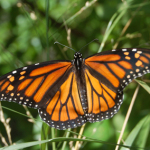 The wondrous aspect of the restoration campaign is that any and all residents living along the Monarch migration path can contribute to this effort by creating habitat for monarchs, through growing one or more of these three varieties of milkweed plants (A. incarnata, A. tuberosa, A. syriaca) in a chemical-free area set aside for pollinators.
The wondrous aspect of the restoration campaign is that any and all residents living along the Monarch migration path can contribute to this effort by creating habitat for monarchs, through growing one or more of these three varieties of milkweed plants (A. incarnata, A. tuberosa, A. syriaca) in a chemical-free area set aside for pollinators.
By Diana Post (with help from Munro Meyersburg)
For past View From Rachel’s Window articles click here

